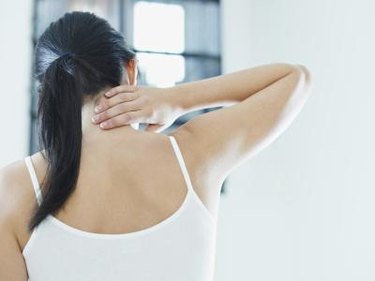
The weighted squat is one the most widely used exercises in all sports by everyone from beginners to professional athletes. Squats offer a great full-body workout, primarily targeting your thighs, hips and back. However, if done incorrectly, it can lead to neck pain after squats.
Read more: Is This the World's Greatest Exercise?
Video of the Day
Video of the Day
Neck Pain After Squats
If your neck hurts after squats, bad form could be the culprit. One of the common errors is descending too quickly and flexing the torso too far forward — this transfers the weight of the bar to your back muscles rather than your legs and hips, according to the American College of Sports Medicine.
Other bad posture habits include not aligning the knees with the direction of your toes. When the knee is not tracking over the toes, it places a lot of pressure on the knee joints.
A lot of people, especially beginners, get into the habit of resting the weight directly on their necks. The bar should rest on your upper back, never on your neck itself. Placing the weight on your neck can cause severe injuries.
Follow these steps for proper execution of back squats, as explained by ExRx.net, to help reduce risk of neck pain after squats.
Look forward as you squat to reduce pressure on your neck.
Stand with your feet shoulder-width apart with the barbell resting on your shoulders, below the base of your neck.
Hinge at the hips and bend your knees. Keep your back straight and your knees aligned over your toes.
Lower yourself until your hips are below parallel — if you're able.
Straighten your knees and hips to return to a fully upright position.
Identify Neck Injuries
Directly placing the weight bar on your neck can cause a neck bruise from squats, injury to the vertebrae or even damage to the spinal cord if the weight is too heavy. Flexing your back and neck muscles against resistance can cause ligament damage in the neck and surrounding areas.
Over-flexing the torso increases the force exerted on the lower back, which in turn may cause spinal disc herniation. Sprain can also occur by sudden contractions and by underdeveloped back muscles. Bad form can cause slipped discs as well.
Preventing Neck Injuries
Begin by just practicing your form to get a feel for the motion and your own strength. If you're just starting out, start by using a trainer to show you the proper technique.
Use spotter arms or have spotter at hand to decrease the chance of injury. Ensure that you position your hands evenly on the bar. The bar should rest comfortably on your shoulders.
Seek Medical Attention
Start slowly and be aware of any pain you feel. Sharp pain is an indication of injury or strain. If you're experiencing sharp pain, stop what you're doing and check with your trainer first.
Seek medical attention for neck pain that is continuous or severe or if your pain radiates down your arms or occurs with headaches, tingling, numbness or weakness, as advised by the American Academy of Orthopaedic Surgeons.
Was this article helpful?
150 Characters Max
0/150
Thank you for sharing!
Thank you for your feedback!
Is this an emergency? If you are experiencing serious medical symptoms, please see the National Library of Medicine’s list of signs you need emergency medical attention or call 911.